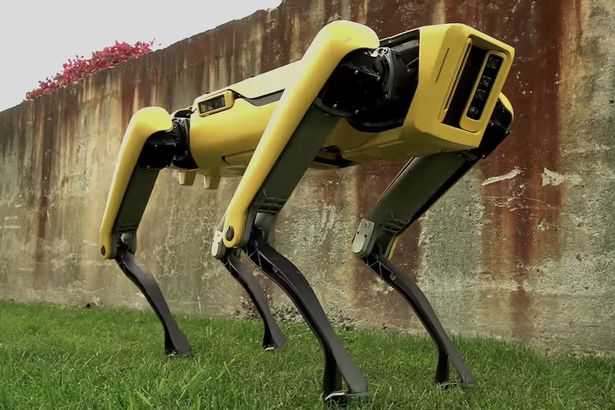Recently, Boston Dynamics released two videos of their latest robotics. One was of Atlas, a robot who can jump, twirl in the air, and do backflips without falling over.
The other is a quadruped that moves so much like an animal, in the dark one might not know the difference.
For context, it was only two years ago, at the DARPA robotics challenge, where robot after robot from the brightest and best minds on Earth fell over trying to ambulate.
Fans of robotics have waited with baited breath for every iteration of the quadrupeds coming out of the Boston Dynamics lab.
If you’re not familiar, Boston Dynamics is the group of nerds working for the defense department to make sure the U.S. has all the best technology. For the last decade or so, they’ve released videos of their creations as they perfect them.
As it turns out, Boston Dynamics wasn’t the first to try to conquer uneven terrain by putting payloads on top of robot legs. Working for the same goal, in 1960, General Electrics created a human-operated quadruped they hoped would replace trucks.
It was, for its time, forward thinking. It also was a clunky mess; what looked like a child’s Erector Set gone wild. They called it a Cybernetic Walking Machine or the Walking Truck.
The Problem with Wheels
When the army first got their gloves on early Jeeps, a clever way of pronouncing the acronym for general purpose vehicles, “GPs,” they were ecstatic.
Until then, the standard road automobile was terrible in combat, especially where there were no roads. War, as it turns out, doesn’t consult Google Maps for ideal locations.
To move people in and out of war zones, they needed something nimble, sturdy, and fast. The first GPs were exactly that by contrast. They’ve only improved since then, but even the most nimble vehicle crossing the Rubicon can only do so at a super slow crawl.
Horses and people can traverse difficult terrain, but they suffer load limitations. An ideal hybrid would capitalize on the load capacity of a Jeep, but with the sure-footedness of a pedal creature.
Four legs are better than two when it comes to managing terrain. Just watch goats climb around. So, General Electric gave it a go making a four-legged truck.
The Walking Truck Solution
Whereas Boston Dynamics robots all operate as autonomous machines, the Walking Truck from GE required a human, who rode inside the truck.
We didn’t yet have machine learning and super powerful, tiny chips. And, as it turns out, navigating uneven surfaces requires massive computing power, normally supplied by the human (or in the case of horses, the horse’s) brain. Dropping a human into the design solved so many challenges.
Bear in mind that this was the 60s. Humanity had not yet witnessed the science fiction movies of the 1980s, like when Ripley took the helm of the power loader in the 1986 movie, Aliens. (Never mind that movie took place in the year 2179.)
This was forward -thinking for the time. It would so advances, it would come to influence the aforementioned science fiction category.
A designer from the movie Star Wars admitted to Gizmodo that they took cues for the Imperial Walker designs from marketing material around the GE Walking Truck.
Thankfully they didn’t refer to the actual truck. The Imperial Walkers would have looked like ads for the Erector Set.
Trucks Didn’t Grow Legs
Since Earth is not littered with walking vehicles, it’s obvious the idea didn’t quite work as well as planned.
GE’s Walking Truck was not only slow, peaking at five mph, it was a bear to operate. Keeping the Walking Truck upright required coordination and endurance.
Movement of the limbs coordinated with the arms and legs of the operator, something like Ripley’s loader in Aliens. Like its future science fiction counterpart, the design of GE’s quadruped came with hydraulic assist, but the operator still had to do work to make it all flow right.
What GE found was that after about fifteen minutes, he couldn’t continue. They would need an operator who didn’t grow weary. They didn’t necessarily know it, but they needed modern computing.
The design for the Walking Truck remains on display in the U.S. Army Transportation Museum in Fort Eustis, Newport, Virginia. It weighs 3,000 pounds, roughly, about as much as modern Jeep Wrangler.
Of course, the military found other means to transport people besides GPs, but it wasn’t by slapping legs on a truck. Not yet, anyway.



